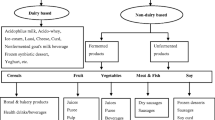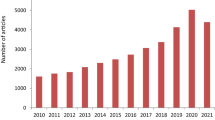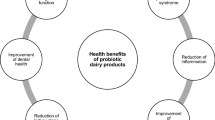Abstract
The existence of an enormous list of traditional fermented foods produced and consumed globally may be considered as the genesis of non-dairy probiotic products. While LABs used as starter cultures showed attributes desirable for a probiotic culture, it was just a matter of time, when scientists and technologists figured out that food matrices which could be fermented could also be used as probiotic delivery vehicles and some starter cultures could perform the dual task of fermentation and probiosis. Meanwhile health has continued to be at the forefront of new product development strategies. The observations that plant carbohydrates and phenolics may act synergistically with probiotics in formulations for gut health have given a shot in the arm for non-dairy probiotic product developers. Today, diverse food innovations are possible through manipulations of synergies between probiotic strain and the components of food matrices, although technological bottlenecks needed to be addressed. However, it is expected that new non-dairy product development will pose its own set of challenges. Each food matrix is unique; the industries need to standardize and optimize the basic formulation for each product that will have the required sensory and physical chemical characteristics, extended shelf life, and chemical stability, all at a reasonable cost. Much has been said about technological complexities and challenges of non-dairy food formats, but despite them, several commercially viable products are already gracing the shelves of supermarkets globally. Food formats like fruit and vegetables juices and cut and whole tissue and cereals seem to be the current favorite, while meat matrix is still in the research stage. The key to success will be to convince consumers to pay the cost for a new product, and it can be achieved through communication of unambiguous and truthful health claims to the consumers.
Access this chapter
Tax calculation will be finalised at checkout
Purchases are for personal use only
Similar content being viewed by others
References
Angelov A, Gotcheva V, Kuncheva R et al (2006) Development of a new oat-based probiotic drink. Int J Food Microbiol 112:75–80
Arihara K (2006) Strategies for designing novel functional meat products. Meat Sci 74:219–229
Arora M, Baldi A (2015) Regulatory categories of probiotics across globe. A review representing existing and recommended categorization. Ind J Med Microbiol 33(5):2–10
Charalampopoulos D, Pandiella SS (2010) Survival of human derived Lactobacillus plantarum in fermented cereal extracts during refrigerated storage. LWT Food Sci Technol 43(3):431–435
Degnan FH (2008) The US food administration and probiotics: regulatory categorization. Clin Infect Dis 46:S133–S136
Dharmasena M, Barron F, Fraser A et al (2015) Refrigerated shelf life of a coconut water-oatmeal mix and the viability of Lactobacillus plantarum Lp 115-400B. Foods 4(3):328–337. https://doi.org/10.3390/foods4030328
Di Cagno R, Coda R, De Angelis M et al (2013) Exploitation of vegetables and fruits through lactic acid fermentation. Food Microbiol 33:1–10
Duda-Chodak A, Tarko T, Satora P et al (2015) Interaction of dietary compounds, especially polyphenols, with the intestinal microbiota: a review. Eur J Nutr 54(3):325–341
Espirito-Santo AP, Catherine FC, Renard MGC (2015) Apple, grape or orange juice: which one offers the best substrate for lactobacilli growth? – a screening study on bacteria viability, superoxide dismutase activity, folates production and hedonic characteristics. Food Res Int 78:352–360
FAO – Food, Agriculture Organization of the United Nations (2006) Statistical yearbook 2005–2006. FAO, Publishing Management Service, Rome
Genevois C, de Escalada PM, Flores S (2017) Novel strategies for fortifying vegetable matrices with iron and Lactobacillus casei simultaneously. LWT Food Sci Technol. https://doi.org/10.1016/j.lwt.2017.01.019
Granato D, Branco GF, Nazzaro F et al (2010) Functional foods and nondairy probiotic food development: trends, concepts, and products. Comp Rev Food Sc Tech 9(3):292–302
Grand View Research (2016) Grand view research. Retrieved December 20, 2016, from Grand View Research. Web site: (http://www.grandviewresearch.com/industry-analysis/probiotics-market)
Gupta S, Cox S, Abu-Ghannam N (2010) Process optimization for the development of a functional beverage based on lactic acid fermentation of oats. Biochem Eng J 52(2–3.) 15):199–204
Jabłońska-ryś E, Sławińska A, Radzki W (2016) Evaluation of the potential use of probiotic strain Lactobacillus plantarum 299v in lactic fermentation of button mushroom fruiting bodies. Acta Sci Pol Technol Aliment 15(4):399–407
Kedia G, Vázquez JA, Pandiella SS (2008) Fermentability of whole oat flour, PeriTec flour and bran by Lactobacillus plantarum. J Food Eng 89:246–249
Klingberg TD, Budde BB (2006) The survival and persistence in the human gastrointestinal tract of five potential probiotic lactobacilli consumed as freeze-dried cultures or as probiotic sausage. Int J Food Microbiol 109(1–2):157–159
Klingberg TD, Axelsson L, Naterstad K et al (2005) Identification of potential probiotic starter cultures for Scandinavian-type fermented sausages. Int J Food Microbiol 105:419–431
Laine R, Salminen S, Benno Y et al (2003) Performance of Bifidobacteria in oat-based media. Int J Food Microbiol 83:105–109
Lee H, Yoon H, Ji Y et al (2011) Functional properties of Lactobacillus strains from kimchi. Int J Food Microbiol 145:155–161
Markets and Markets (2016) Research insight: new revenue pockets – probiotics market. Retrieved December 27, 2016, from Markets and Markets. http://www.marketsandmarkets.com/ResearchInsight/probiotic-ingredient.asp.
Mashayekh S, Hashemiravan M, Mokhtari FD (2016) Study on chemical and sensory changes of probiotic fermented beverage based on mixture of pineapple, apple and mango juices. J Curr Res Sci 4(3):1–5
Matilla-Sandholm T, Myllarinen P, Crittenden R, Mogensen G, Fonden R, Saarela M (2002) Technological challenges for future probiotic foods. Int Dairy J 12:173–182
Mauro CSI, Guergoletto KB, Garcia S (2016) Development of blueberry and carrot juice blend fermented by Lactobacillus reuteri LR92. Beverages 2(4):37–40. https://doi.org/10.3390/beverages2040037
Mosso AL, Lobo MO, Cristina Sammán N (2016) Development of a potentially probiotic food through fermentation of Andean tubers. LWT Food Sci Technol 71:184–189
Neffe-Skocińska K, Jaworska D, Kołożyn-Krajewska D et al (2015) The effect of LAB as probiotic starter culture and green tea extract addition on dry fermented pork loins quality. Bio Med Res Int, Article ID 452757. doi.org/10.1155/2015/452757
Negi B, Dey G (2009) Comparative analysis of total phenolic content in sea buckthorn wine and other selected fruit wines. World Acad Sci, Eng Technol Int J Biol Biomol Agric Food Biotechnol Eng 3(6):300–303
Nematollahi A, Sohrabvandi S, Mohammad A et al (2016) Viability of probiotic bacteria and some chemical and sensory characteristics in cornelian cherry juice during cold storage. Electron J Biotechnol 21:49–53
Ozdal T, Sela DA, Xiao J et al (2016) The reciprocal interactions between polyphenols and gut microbiota and effects on bioaccessibility. Forum Nutr 8(2):78–83
Prado FC, Lindner JDD, Inaba J et al (2015) Development and evaluation of a fermented coconut water beverage with potential health benefits. J Funct Foods 12:489–497
Puupponen-Pimiä R, Aura AM, Oksman-Caldentey KM et al (2002) Development of functional ingredients for gut health. Trends Food Sci Technol 13(1):3–11
Rahavi EB, Kapsak WR (2010) Health and wellness product development. In Prepared foods network http://www.prepared foods.com/Articles/Feature_Article/BNP_GU ID_9-5-2006_A_10000000000000752310. Access on 18 Sept 2010
Rouhi M, Sohrabvandi S, Mortazavian AM (2013) Probiotic fermented sausage: viability of probiotic microorganisms and sensory characteristics. Crit Rev Food Sci Nutr 53(4):331–348. https://doi.org/10.1080/10408398.2010.531407
Ruiz-Moyano S, Martín A, Benito MJ et al (2008) Screening of lactic acid bacteria and bifidobacteria for potential probiotic use in Iberian dry fermented sausages. Meat Sci 80:715–721
Russo P, Peña N, de Chiara MLV et al (2015) Probiotic lactic acid bacteria for the production of multifunctional fresh-cut cantaloupe. Food Res Int 77:762–772
Salmerón I, Thomas K, Pandiella SS (2014) Effect of substrate composition and inoculum on the fermentation kinetics and flavour compound profiles of potentially non-dairy probiotic formulations. LWT Food Sci Technol 55(1):240–247
Salmerón I, Thomas K, Severino S et al (2015) Effect of potentially probiotic lactic acid bacteria on the physicochemical composition and acceptance of fermented cereal beverages. J Funct Foods 15:106–115
Selma MV, Espín JC, Tomás-Barberán FA (2009) Interaction between phenolics and gut microbiota: role in human health. J Agric Food Chem 57(15):6485–6501
Sidira M, Kandylis P, Kanellaki M et al (2015) Effect of immobilized Lactobacillus casei on volatile compounds of heat treated probiotic dry-fermented sausage. Food Chem 178(1):201–207
Sireswar S, Dey G, Dey K et al (2017a) Evaluation of probiotic L. rhamnosus GG as a protective culture in sea buckthorn-based beverage. Beverages 3(4):48–54
Sireswar S, Dey G, Sreesoundarya TK et al (2017b) Design of probiotic-fortified food matrices influence their antipathogenic potential. Food Biosci 20:28–35
Swetwiwathana A, Visessanguan W (2015) Potential of bacteriocin-producing lactic acid bacteria for safety improvements of traditional Thai fermented meat and human health. Meat Sci 109:101–105
Valdés L, Cuervo A, Salazar N et al (2015) The relationship between phenolic compounds from diet and microbiota: impact on human health. Food Funct 6:2424–2439
Vitali B, Minervini G, Rizzello CG et al (2012) Novel probiotic candidates for humans isolated from raw fruits and vegetables. Food Microbiol 31:116–125
Wu H, Rui X, Li W et al (2015) Mung bean (Vigna radiata) as probiotic food through fermentation with Lactobacillus plantarum B1-6. LWT Food Sci Technol 63(1):445–451
Author information
Authors and Affiliations
Corresponding author
Editor information
Editors and Affiliations
Rights and permissions
Copyright information
© 2018 Springer International Publishing AG, part of Springer Nature
About this chapter
Cite this chapter
Dey, G. (2018). Non-dairy Probiotic Foods: Innovations and Market Trends. In: Panda, S., Shetty, P. (eds) Innovations in Technologies for Fermented Food and Beverage Industries. Food Microbiology and Food Safety. Springer, Cham. https://doi.org/10.1007/978-3-319-74820-7_9
Download citation
DOI: https://doi.org/10.1007/978-3-319-74820-7_9
Published:
Publisher Name: Springer, Cham
Print ISBN: 978-3-319-74819-1
Online ISBN: 978-3-319-74820-7
eBook Packages: Chemistry and Materials ScienceChemistry and Material Science (R0)




